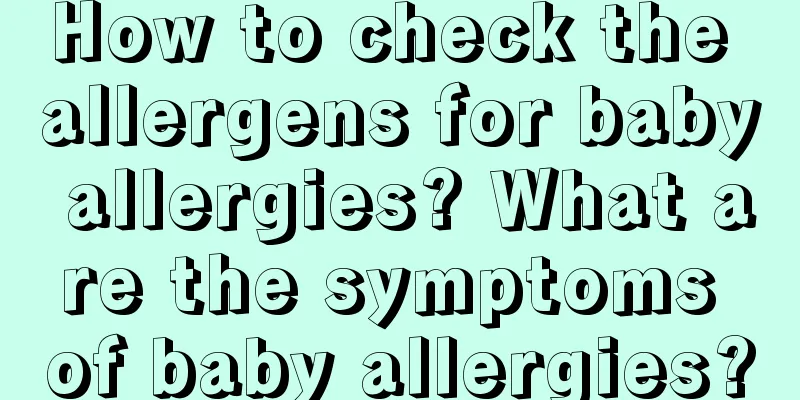How to check the allergens for baby allergies? What are the symptoms of baby allergies?

|
The baby's skin is delicate and fragile, and it is easy to be hurt. Sometimes a lot of small red spots suddenly appear on the baby's body, and new mothers don't know what food the baby ate or what he touched that caused the allergy. How to check the allergens for baby allergies1. Food record method: When checking for allergies in children, you should first make a food record. Mainly, you need to record the food the baby eats every day, the reaction after eating, and the time when the allergy occurred. If the baby has an allergic reaction after ingesting a certain food, you can find out the relationship between the food and the baby's allergy. Although this method is very simple, it is difficult to get accurate results. 2. Skin test: Skin test is a common method for clinical allergen detection. This method is simple and easy for children to accept. It mainly involves sucking liquid containing milk, soybeans and other foods into an empty needle, and then making multiple pricking points on the child's skin to observe the child's reaction. However, the digestion process of food in the body is very complicated, and a positive result also requires comprehensive clinical analysis. What are the symptoms of baby's allergic constitution?1. Skin: Babies with allergic constitutions are prone to some skin diseases, the most common of which are eczema and dermatitis. After the onset of the disease, red spots or small papules will appear on the skin, with severe itching. Scratching with hands can cause skin lesions to ulcerate, and severe cases will cause exudation. Babies with eczema will also become anxious and restless, often crying and making a fuss. Severe cases will cause difficulty in falling asleep. Therefore, if your baby has an allergic constitution and often has skin problems, you should reduce the number of times you go out during the pollen season. 2 Digestive system: Babies with allergic constitutions are prone to physiological diarrhea, which is mainly caused by lactose intolerance. In addition, they may have symptoms such as frequent farts, loud noises, and hiccups after feeding, but these symptoms will generally improve after the baby has added complementary foods. 3 Other symptoms: Babies with allergic constitutions are prone to catching colds, and their constitutions are worse than other children. They often sneeze. When going out, they often rub their eyes and pick their noses, and often have runny noses and sneeze one after another. These symptoms show that babies are very sensitive to the outside air and will feel uncomfortable if there is something wrong. In addition, babies with allergic constitutions will have redness around their eyebrows. Especially when crying, the redness of the eyebrows becomes more obvious. Baby allergy precautions1. You can supplement calcium and vitamins for your baby. You can also supplement your baby's diet by letting your baby eat more nutritious foods such as tomatoes and broccoli. Improve immunity and strengthen your body. If your baby often has allergies, you can apply some ointment, which has no side effects and can also play an anti-inflammatory role. However, this method is not recommended for parents to use for their babies frequently. 2. After the baby is allergic, it will itch. Parents should first stop the itching and reduce inflammation. During this period, the baby needs to take some medicine to treat allergies. After a few days, the symptoms will be much better. In order to prevent the baby from continuing to have allergies, parents should pay attention to the baby's usual diet and the environment in which the baby lives, and cut off some factors that cause the baby's allergies. Causes of baby allergiesThe triggers of allergic reactions generally fall into two categories: 1. Direct factors: including allergens, respiratory viral infections, chemical irritants such as cigarette nicotine, car exhaust, ozone, etc. These factors can directly induce allergic symptoms. 2. Indirect factors: such as exercise, drastic weather changes, indoor and outdoor temperature difference greater than 7°C, drinking ice water, emotional instability, etc. These factors can cause the contraction of organs that already have allergic inflammation, such as the bronchi. Common inhaled allergens include household dust, dust mites, feathers, cat dander, dog dander, fungi, cockroaches, and pollen; food allergens include: milk, eggs, peanuts, nuts, soybeans and soy products, wheat, crabs, shrimps, cod, clams and other seafood. Among these allergens, household dust mites are the most common. |
<<: Is the mumps vaccine self-paid or free? Is it necessary to get the mumps vaccine?
Recommend
Where does Synutra UBO milk powder come from? Where does Synutra UBO milk powder come from?
The source of Synutra U-Breast milk powder is a q...
What to do if your baby has diarrhea? Symptoms of diarrhea in your baby
Diarrhea is very common in babies. Since babies a...
Dietary taboos for babies with precocious puberty What foods should babies with precocious puberty not eat?
There are many taboos for babies to eat during ea...
How to avoid miscarriage during pregnancy How to have safe sex during pregnancy
The issue that many expectant fathers and mothers...
What to do if a woman has few eggs
The development of a smart baby starts from the e...
What causes baby eczema? How to take care of baby eczema and make it heal quickly?
Since babies are born not long ago, they will hav...
Can I wean my baby in summer? Why is it not a good idea to wean my baby in summer?
Weaning is something that every baby of the right...
What should pregnant women eat when their blood sugar is high? What should pregnant women not eat when their blood sugar is high?
Pregnant women with high blood sugar should contr...
Why do babies have eczema on their faces? What behaviors can affect the quality of a baby's sleep?
The baby's skin is very fragile, so it needs ...
The order of adding baby food teaches you how to make your baby love eating complementary food
When babies reach the age to eat complementary fo...
What should the weaning process be like? What issues should be paid attention to during the weaning process?
Many babies will be weaned at a certain time. So,...
What is the reason for baby's hair loss? What is the reason for baby's hair loss?
The discovery of hair loss is not limited to adul...
Can postpartum repair be done at home? Can postpartum repair improve sagging?
For mothers who have just given birth, postpartum...
Can babies eat a lot of amaranth? What can babies eat to enhance their immunity?
Babies' physical health is weaker than that o...
What is the reason for a one-month-old baby to spit bubbles?
The baby has been developing for more than one mo...









